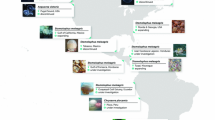Abstract
A few large jellyfish species in the order Rhizostomeae constitute an important food in Chinese cooking. For more than 1700 years, they have been exploited along the coasts of China. Such jellyfish became an important fishery commodity of Southeast Asian countries in the 1970s with increasing demand from the Japanese market. Recently, Japan has imported 5400–10 000 tons of jellyfish products per year, valued at about 25.5 million US dollars, annually from the Philippines, Vietnam, Thailand, Malaysia, Indonesia, Singapore and Myanmar. Judging from the type names at market and the external appearance of the semi-dried products, the edible jellyfish harvest in Southeast Asia is composed of more than 8 species. They are caught by various kinds of fishing gear including set-nets, drift-nets, hand-nets, scoop-nets, beach-seines and hooks. The fishery is characterized by large fluctuations of the annual catch and a short fishing season that is restricted from two to four months. The average annual catch of jellyfish between 1988 and l999 in Southeast Asia is estimated to be about 169 000 metric tons in wet weight and the worldwide catch is approximately 321 000 metric tons. Needs for future study on the biology of rhizostome jellyfish are discussed as they relate to understanding population fluctuations.
Similar content being viewed by others
References
Ding, G.-W & J.-K. Chen, 1981. The life history of Rhopilema escuenta Kishinouye. J. Fish. China. 5: 93–102 (in Chinese).
Food and Agriculture Organization of United Nations, 1999. http//www.fao.org/fi/statist/FISOFT/FISHPLUS.asp
Hon, H.-C., S.-M. Chang & C.-C. Wang, 1978. Hai tsue (edible jellyfish). Science Publications, Beijing: 70 pp. (in Chinese).
Hsieh, Y-H. & J. Rudloe, 1994. Potential of utilizing jellyfish as food in western countries. Trends Food Sci. Technol. 5: 225–229.
Hsieh, Y-H.P., F.-M. Leong & J. Rudloe, 2001. Jellyfish as food. Hydrobiologia 451 (Dev. Hydrobiol. 155): 11–17.
Kishinouye, K., 1922. Echizen kurage. Doubutsugaku zasshi 34: 343–346 (In Japanese).
Kramp, P. L., 1961. Synopsis of the medusae of the world. J. mar. biol. Ass. U. K. 40: 1–469.
Larson, R. J., 1991. Diet, prey selection and daily ration of Stomolophus meleagris, a filter-feeding scyphomedusa from the NE Gulf of Mexico. Estuar, coast. shelf Sci. 32: 511–525.
Omori, M., 1981. Edible jellyfish (Scyphomedusae: Rhizostomeae) in the Far East waters: a brief review of the biology and fishery. Bull. Plankton Soc. Japan 28: 1–11 (in Japanese).
Rumpet, R., 1991. Some aspects of the biology and fishery of jellyfish found along the coast of Sarawak, Malaysia. Dept. of Fisheries, Ministry of Agriculture, Malaysia: 37 pp.
Shimomura, T., 1959. On the unprecedented flourishing of 'Echizen-kurage', Stomolphus nomurai (Kishinouye), in the Tsushima warm current regions in autumn, 1958. Bull. Japan Sea Reg. Fish. Res. Lab. 7: 85–107 (in Japanese).
Soonthonvipat, V., 1976. Dried jellyfish. In Kieros, T. (ed.), Seminar Fisheries Resources and their Management in Southeast Asia. German Foundation International Development, Bonn: 149–151.
South China Sea Institute of Oceanology, Academia Sinica, 1978. Medicinal Organisms in the South China Sea. Science Publications, Beijing, 153 pp. (in Chinese).
Uchida, T., 1954. Distribution of scyphomedusae in Japanese and adjacent waters. J. Fac. Sci., Hokkaido Univ. Ser. 6, Zool. 12: 209–219.
Wu, B-L., 1955. Hai-tsue (Rhopilema esculentum). Sheng Fu Xie Tong Bao [Biological Newsletter] 4: 35–40 (in Chinese).
Wyrtki, K., 1961. Physical Oceanography of the Southeast Asian Waters. Naga Rep. 2: 1–195.
Yasuda, T., 1995. Mass occurrence of Stomolophus nomurai was seen again. Umiushi Tsusin 9: 6–8 (in Japanese).
Author information
Authors and Affiliations
Rights and permissions
About this article
Cite this article
Omori, M., Nakano, E. Jellyfish fisheries in southeast Asia. Hydrobiologia 451, 19–26 (2001). https://doi.org/10.1023/A:1011879821323
Issue Date:
DOI: https://doi.org/10.1023/A:1011879821323




